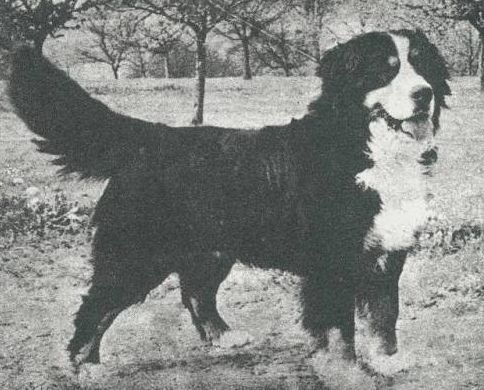Bernese History
Today, there are four (4) distinctive breeds of Swiss Mountain Dogs.
From smallest size to largest, these are:
Entlebucher (15.5 to 19.5 inches, appx 55 to 66 lbs)
Appenzeller (19 to 22.5 inches, appx 61 to 77 lbs)
Bernese Mountain Dog (23 to 27.5 inches, appx 80 to 120 lbs)
Greater Swiss Mountain Dogs (23.5 to 28.5 inches, appx 80 to 130 lbs)
 The Bernese Mountain Dog breed began as various tri-colored farm dogs in the rural area of Berne, Switzerland. Through a colorful history full of dedicated people/breeders, like Franz Schertenleib, Gottfried Mumenthaler and Professor Albert Heim, these tri-colored farm dogs were developed into a standard breed we know today as the Bernese Mountain Dog.
The Bernese Mountain Dog breed began as various tri-colored farm dogs in the rural area of Berne, Switzerland. Through a colorful history full of dedicated people/breeders, like Franz Schertenleib, Gottfried Mumenthaler and Professor Albert Heim, these tri-colored farm dogs were developed into a standard breed we know today as the Bernese Mountain Dog.
Interestingly, in 1947, there were a great many discussions about bringing in an outcross because of issues like temperament problems (excessive shyness, etc.), a general lacking in bone and substance and other maladies. In 1948, perhaps in response to these discussions, there was a total outcross breeding with a Newfoundland Dog named Pluto v Erlengut. Most believe this breeding Progenitor of our modern Bernese breed type to have brought solid temperament, bone, substance and other good things to the Berner breed. Alex v Angstorf, a direct descent of that Newfie, is considered to be the progenitor of our current standard Bernese breed type.
In order to create this breed, great detail was given to creation of and adherence to a standard breed type. Unworthy stock was stringently not allowed to breed. The European Show Rings helped conscientious breeders prove the best breeding stock. Considerations of the original duties upheld by the tri-colored Swiss farm dogs were also a foundational part of choosing breeding stock.
Originally, Berners were working dogs. They were cheaper to buy and maintain than horses. So many Swiss frugal dairy farmers, weavers, butchers and other craftsmen used these dogs as draught dogs. Although Swiss dairy farmers used Berners as cattle-drovers, they were mostly used as draught dogs and, as a side benefit, watch dogs. These tri-colored farm dogs demonstrated the power, stability, endurance and temperament to pull heavy carts through the Swiss Alps down into local villages and also be a dairy farmers close working partner on the farm. During the World Wars in Europe, most vehicles were commandeered for the war effort. So in many European communities, the drafting ability of Berners was used to replace vehicles, as well as horses, during that time.
Many people in the Berner Fancy today continue the tradition of Berners pulling carts, a performance event called 'Drafting'. Today's Fanciers also work with their Berners in other performance events, like Obedience and Agility.
Over the years, many devoted Berner lovers have spent great effort, time, money and heartache developing the wonderful Bernese Mountain Dog breed we enjoy today.
This labor of love has been passed on to our generation. Its our turn to protect and nurture the Bernese Mountain Dog breed, carrying the torch given us by the dedicated people who forged this noble dog breed.
If you bring a Bernese Mountain Dog into your home, we hope you'll do your part to help protect and nurture this wonderful breed.